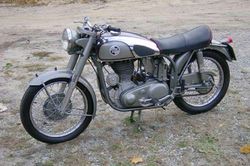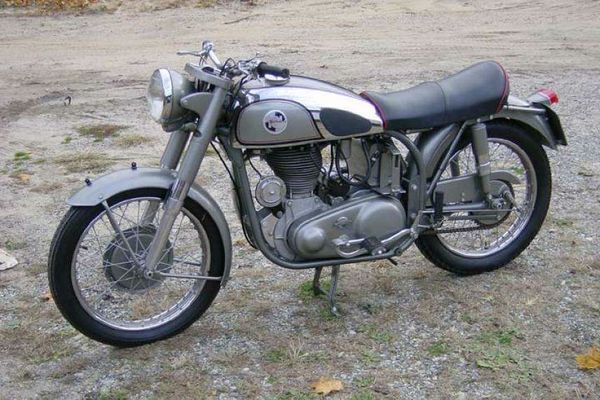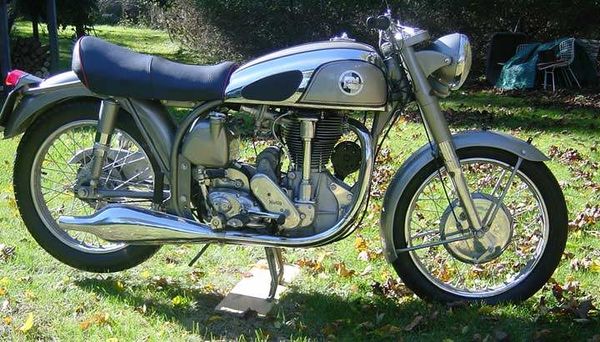Norton nternational Model 30
 |
|
| Norton nternational Model 30 | |
| Manufacturer | |
|---|---|
| Production | 1955 |
| Engine | Four stroke, single cylinder, SOHC |
| Compression ratio | 7.23:1 |
| Top Speed | 156 km/h / 97 mph |
| Ignition | Lucas dynamo |
| Transmission | 4-Speed, close ratio |
| Frame | Cradle type |
| Suspension | Front: Roadholder telescopic fork Rear: Undamped plungers |
| Brakes | Front: Drum Rear: Drum |
| Wheelbase | 1410 mm / 55.5 in |
| Weight | 176 kg / 390 lbs (dry), |
| Manuals | Service Manual |
It could reach a top speed of 156 km/h / 97 mph.
Engine[edit | edit source]
The engine was a Air cooled cooled Four stroke, single cylinder, SOHC. The engine featured a 7.23:1 compression ratio.
Chassis[edit | edit source]
Stopping was achieved via Drum in the front and a Drum in the rear. The front suspension was a Roadholder telescopic fork while the rear was equipped with a Undamped plungers. The bike weighed just 176 kg / 390 lbs. The wheelbase was 1410 mm / 55.5 in long.
Photos[edit | edit source]
Overview[edit | edit source]
Norton International Model 30
In pre-war days, the Norton Model 30 had been the
racing flagship of the range, but by World War 2 the pure racers had already
begun to diverge from the publicly available International. When post-war
production resumed in 1947, the 'Inter' had found a niche as a fast sporting
roadster, and its single overhead-cam engine had become a vastly different
proposition from the double overhead-cam racing Manx models.
The Inters achieved steady, though limited, sales
for the next few years, and while some die-hard enthusiasts continued to race
them in amateur competition, they were becoming dated against competition that
included Triumph twins and the BSA Gold Star. Even so, several Clubman's TT
winners of the late 1940s were mounted on Internationals fitted with special
racing equipment, including an alloy cylinder barrel in place of the roadster's
cast iron.
The final stage of development of the Inter came
in 1953, when the alloy engine was installed in Norton's latest racing frame,
the Featherbed, together with a new gearbox of the current design. In this form
the International won its final Clubman's TT, although the Featherbed model was
really intended as a sports special for fast road work.
The International's Featherbed frame was not
quite a replica of the pure racers, but it was built to a higher standard than
its roadster brothers. In any form, the Featherbed became the standard by which
all handling would be judged for two decades, and with some of the best
telescopic forks in the business, and braking to match, it could be pushed to
the limit of its engine's considerable performance.
As a racing engine the 490cc overhead-cam unit
although supremely rugged and reliable, was not very practical. It could be
tricky to set up, with running clearances adjusted by numerous shims, and an
oiling system that
relied on several hard-to-reach adjustable jets.
The valves remained exposed resulting in
incurable oil leaks. Roadster silencing stifled performance, and by the late
1950s it was possible to get the same level of power from a Norton Dominator.
But such complaints missed the point. Full of class, sound and fury, the Inter
both handled and braked superbly and allowed its lucky owner to believe that he
was riding a real racer on the road.
The International was always expensive and by
1956 it was made to special order only. The last of the line left the works in
1958, when fewer than 20 were made. But the Inter had a pedigree borrowed from
some of the most famous British racers, and a performance that kept riders
enthralled for decades.
| Make Model. | Norton International Model 30 |
|---|---|
| Year | 1955 |
| Engine Type | Four stroke, single cylinder, SOHC |
| Displacement | 490.1 cc / 29.9 cu in |
| Bore X Stroke | 79 x 100 mm |
| Cooling System | Air cooled |
| Compression | 7.23:1 |
| Induction | PAzin Amal TT carburetors |
| Ignition | Lucas dynamo |
| Starting | Kick |
| Max Power | 22 kW / 29.5 hp @ 5500 rpm |
| Transmission | 4-Speed, close ratio |
| Final Drive | Chain |
| Gear Ratios | 1st 10.8 / 2nd 6.18 / 3rd 5.1 / 4th 4.64:1 |
| Frame | Cradle type |
| Front Suspension | Roadholder telescopic fork |
| Rear Suspension | Undamped plungers |
| Front Brakes | Drum |
| Rear Brakes | Drum |
| Wheels | Steel, laced wire spokes |
| Front Rim | 3.00 x 21" |
| Rear Rim | 3.50 x 20" |
| Wheelbase | 1410 mm / 55.5 in |
| Dry Weight | 176 kg / 390 lbs |
| Top Speed | 156 km/h / 97 mph |

